► FK8 Honda Civic Type R review
► 316bhp, 169mph, from £30,995
► First Type R to be sold in USA
In response to increased competition from pretty much everyone, Honda has expanded its Type R range to include three new trims. The standard Type R remains, but now it’s flanked by an extreme Limited Edition model, and a slightly more understated Sport Line model. Keep reading for our comprehensive look at all three models.
Type R Sport Line review
Designed to be a more sedate, mature version of the standard Type R, the Sport Line makes a few key changes compared to the standard car. A lower spoiler replaces the ‘downforce sculpture’ of the standard Type R, while the alloy wheels are now just 19-inches (one-inch smaller) and don’t have a red pinstripe. And that’s it.
Wing aside, the Sport Line is identical inside and out, and if anything, it looks more aggressive now there’s no rear wing to draw your attention away from it. Let’s call that the GT3 Touring effect.
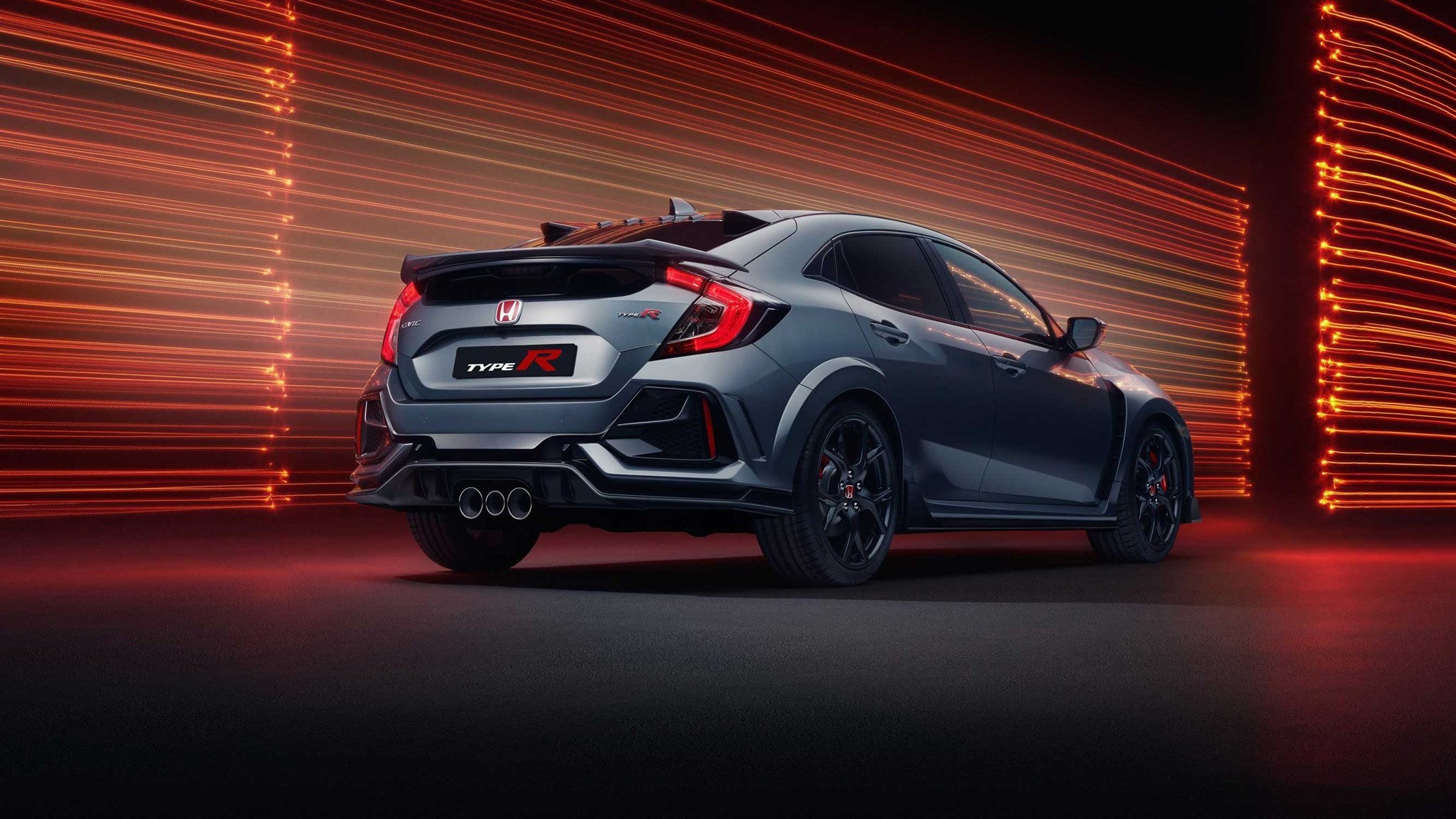
Everything else? Just the same as the Type R – but that’s no bad thing. Everything the driver touches feels exactly as you’d want; gear shifts are still class-leading, the throttle and brake pedals are weighted perfectly giving you both confidence and precision – and the steering is always on the right side of heavy, whatever mode you’re in.
You still get 316bhp of turbo-assisted shove and when pushed, the extra inch of sidewall and lack of rear wing don’t seem to make a difference. But they do make a bigger impact in more sedate driving; ride quality is far more suited to UK roads in Comfort mode, and motorways felt slightly less arduous than in the Type R GT car. In this case, there’s hardly any compromise between comfort and handling.
Anything else?
It’s worth adding that the boot is still 420-litres and there’s still an intuitive adaptive cruise control system to round out the Civic’s practicality.
Quick verdict
Honda’s efforts to tone down the styling of the Type R have made little difference, but a slightly change to the tyres mean the ride is now even better before. The Sport Line is a Type R with an ever so slightly larger performance window, and marginally less divisive looks. That’s a good thing.
Type R GT Review
Some cars feel just right from the first few moments you’re rolling – driving position, pedal weights, steering response – and the 2017 Honda Civic Type R is one of those cars.
Following a brief acquaintance with a pre-production car at Honda’s Tochigi test centre, this is our first proper drive in the fourth-generation Honda Civic Type R (called the FK8 in Honda code-speak) on the public road. We’ve driven it over a mix of rural roads and autobahn stretches near Dresden, as well as a few laps around the Lausitzring circuit – and there’s plenty to like.
The just-retired previous-gen CTR was a thrilling car, but one that did its best work on the right road in the right moment. It was roomy and practical, but its uncompromising suspension set-up, slightly woolly throttle response, raucous road noise and divisive styling counted against it.
The even more outlandish bodykit of the new car suggests it’ll be yet more extreme to live with, but that’s not the case. Based on first aquaintances (within the usual restricted timeframe of an international launch), the latest CTR is an even more thrilling, yet far more well rounded hot hatch. It’s a good ’un.
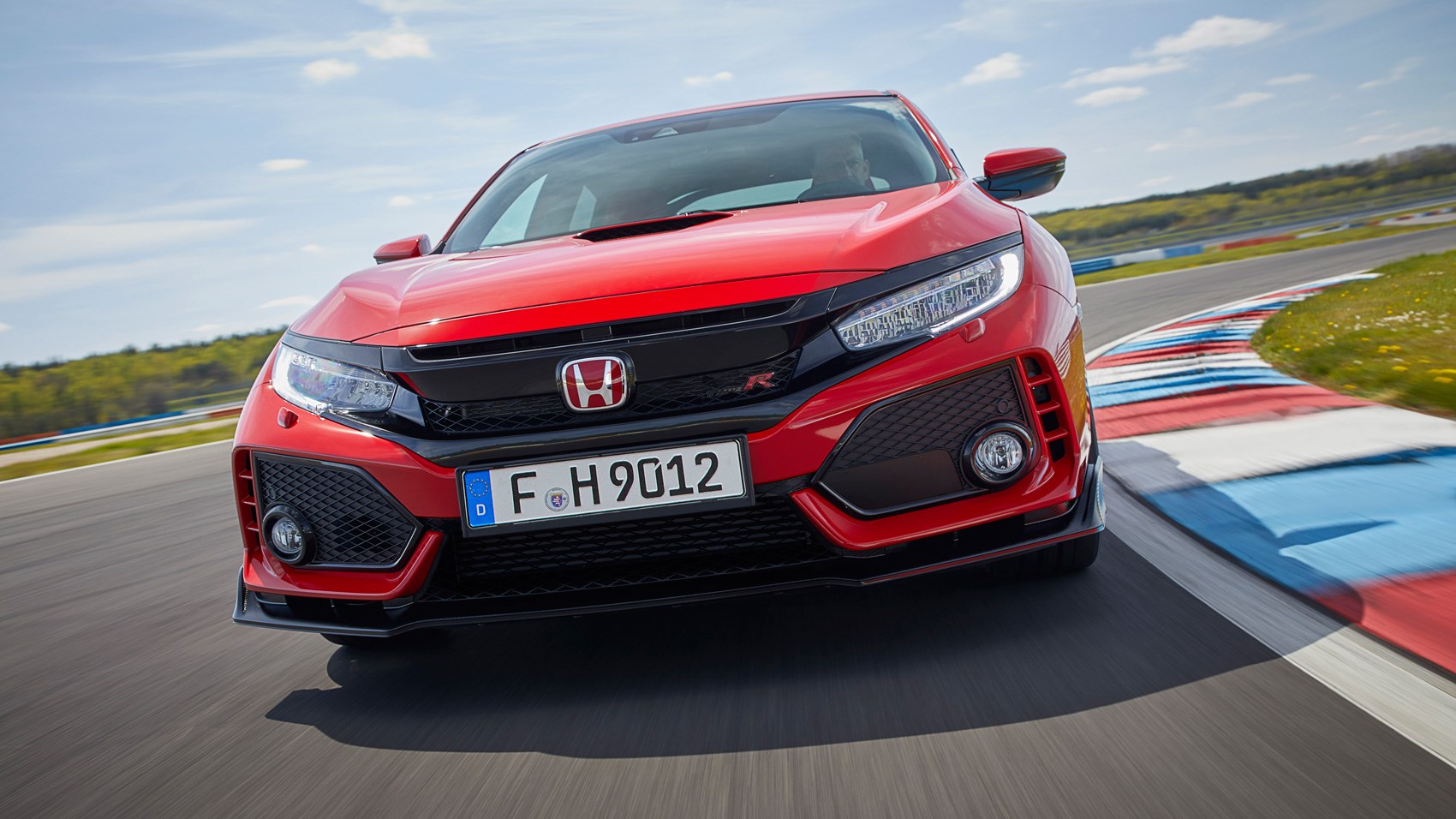
A new Civic Type R already? It doesn’t feel that long since the last one?
We had to wait a good old while for the previous 2015-2016 ‘FK2’ Civic Type R to arrive, with a gap of approximately three years after its predecessor ended production. But the new FK8 Type R was developed in parallel with the latest-generation Civic base models from the beginning, resulting in a much earlier launch (and a comparatively early bath for the FK2 compared with most cars’ production lifecycles).
This is a hot hatch launch with no little buzz about it too, as a pre-production prototype Type R has recorded the fastest ever timed lap of the Nurburgring for a front-wheel-drive production car (albeit one that wasn’t wearing production tyres) at 7m43.8s, nearly 7sec faster the FK2.
What’s under the bonnet?
An evolution of the FK2’s turbocharged 2.0-litre four-cylinder VTEC, now with power upped to 316bhp.
That increase of around 10bhp comes primarily from increased volume of the exhaust system, and resultant reduced back-pressure.
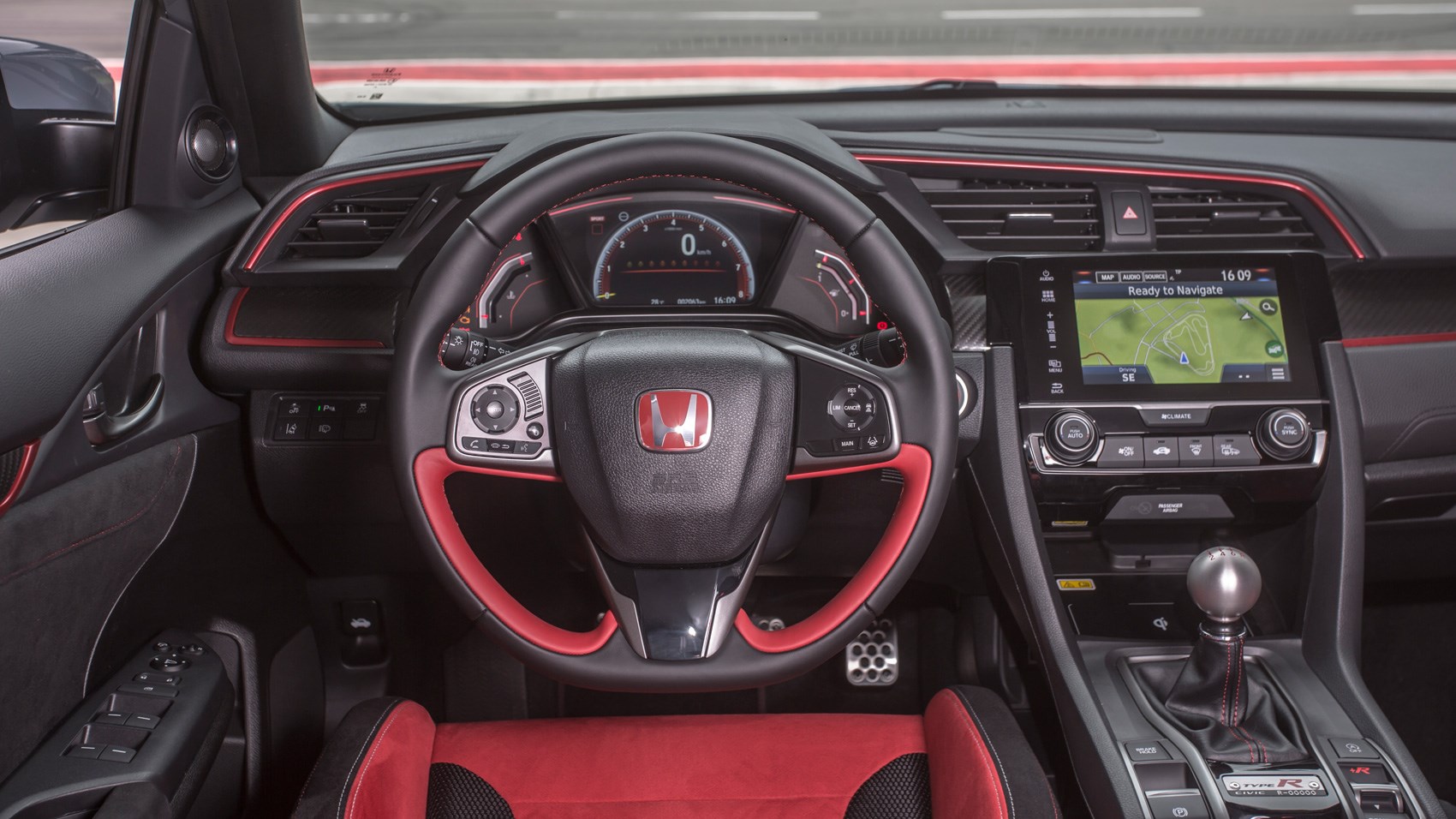
As before, the CTR is offered only with a six-speed manual gearbox, this time with shorter ratios than before (and yet a higher top speed, courtesy of the extra power and reduced drag), and an automatic throttle-blipping rev-match function on downshifts (which can be switched off if you prefer to DIY).
‘We never seriously considered an automatic gearbox option,’ the Type R’s large project leader Hideki Kakinuma told CAR. ‘If you look at all the previous Type Rs, they were all manual. The reason is very simple – the pleasure of operating the gearbox is part of what makes the car fun to drive.’
That bodykit looks pretty wild. All for show, or does it actually do something?
Honda says the Civic Type R’s design was ‘very focused on aerodynamics.’ It produces more downforce than its FK2 predecessor, but also 3% less drag overall at high speed. Honda claims it is the only hot hatch in the C-segment which produces no lift whatsoever, only downforce. (The boxy bodykit on VW’s Golf Clubsport generated a small amount of downforce, although that car’s no longer on sale.)
The giant rear wing was reputedly shaped by data from Honda’s World Touring Car Championship car, while the sharkfin-style flick-ups on the sills and the trailing edges of the front bumper also contribute to overall downforce without adding too much drag. The odd-looking ridges on the roof are so-called vortex generators, which sounds like they create turbulence, but they’re actually guides to better channel the air onto the rear wing.
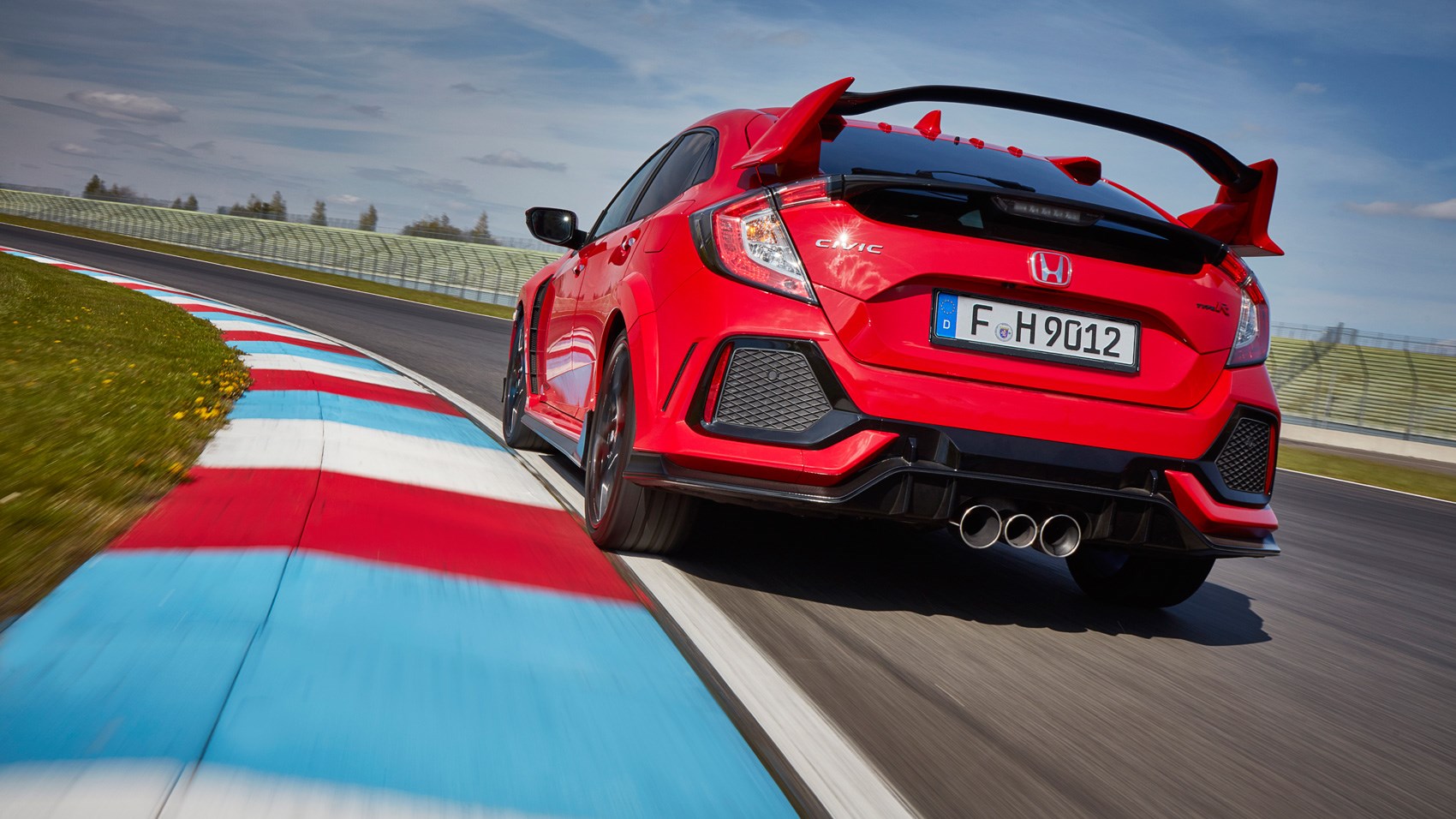
Despite the wing’s size, it’s positioned in such a way that it doesn’t block the rear-view mirror.
The big scoop in the bonnet is there because heat management is, unsurprisingly, ‘an important issue with cars like this’, Honda says. No comment on the fake air outlets in the rear bumper.
What about suspension?
Big news here is that the previous car’s torsion-beam rear suspension has been changed to a multi-link arrangement. One of the primary benefits is greater stability under braking, with the rear wheels set up to adopt a subtle degree of toe-in as weight shifts forward.
As before, there are MacPherson struts up front, with revised geometry. There are adaptive three-chamber dampers all round, this time with a wider range of driving modes to select from – more on which later.
The power steering has been altered to a variable-ratio set-up, becoming more direct as more lock is added, and thus requiring less arm-twirling.
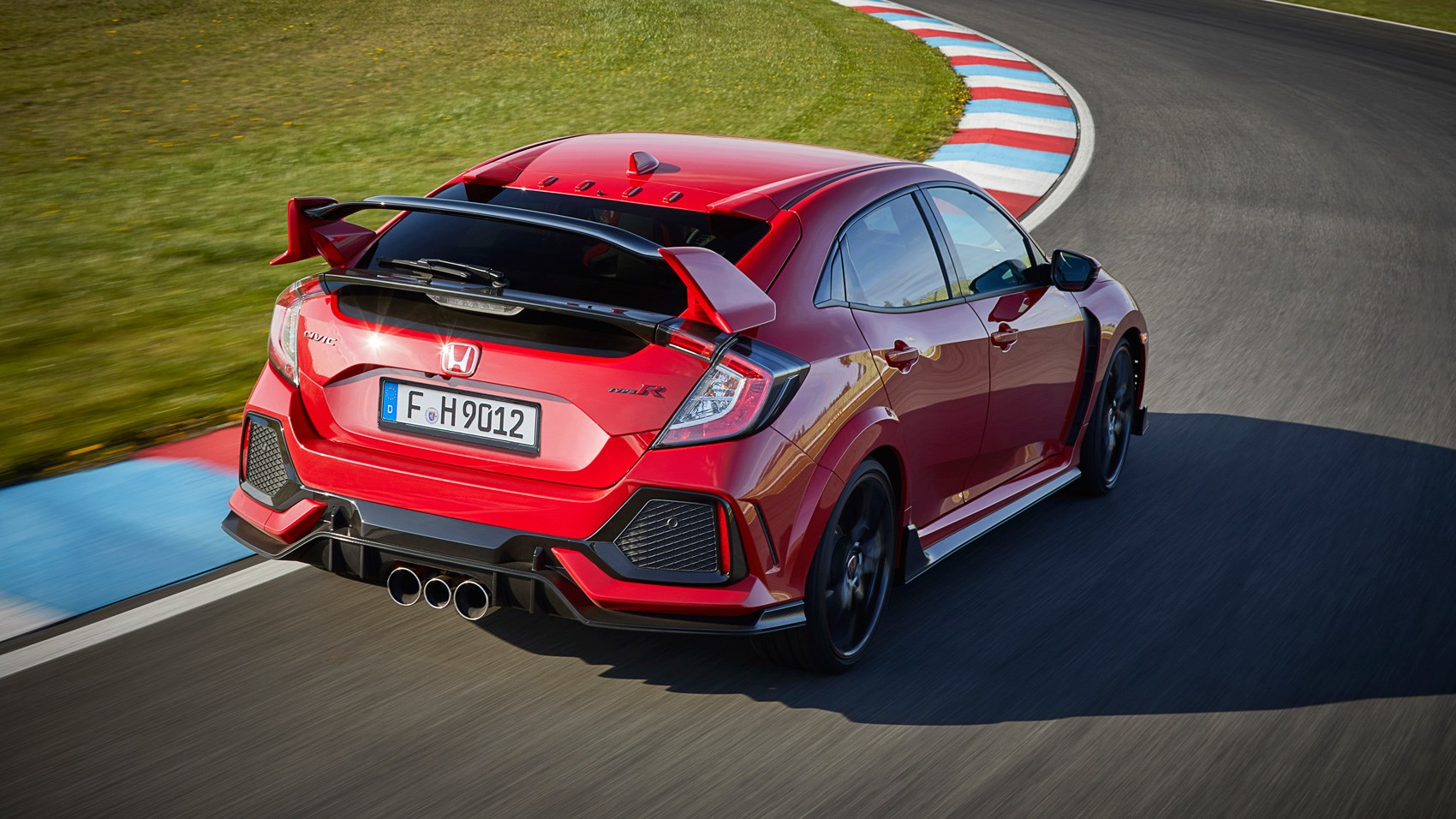
Another big change is a relocation of the fuel tank, from below the front seats to a more conventional position under the rear seats. Multiple upshots here: a lower driving position, by a substantial 50mm; a lower centre of gravity overall, for greater stability; and the inevitable loss of the cinema-style flip-up ‘magic seats’ in the rear.
That applies to the regular Civic too. ‘The fact that we planned the Type R [to be developed in parallel] from the outset [has] also had a huge impact on the performance abilities of the base Civic,’ we were told. The Type R’s bodyshell is 16kg lighter and 38% torsionally stiffer than the FK2, and the wheelbase is considerably longer – by 95mm – for increased stability.
The tyres, specially developed by Continental, are an inch bigger in diameter than before, at 20 inches, and 10mm wider at 245/30 R20. They wrap a set of very tasty, and worryingly kerbable-looking, black ’n’ red-pinstriped alloys. Honda describes them as ‘very comparative to Michelin Pilot Cup 2s’ (soft, track-focused tyres as used by multiple high-end hot hatches) in performance.
That’s enough tech chat. What’s it like to drive?
As mentioned at kick-off, you can tell Honda’s got an awful lot of things right within the first few metres.
The lower driving position is spot-on, the brake pedal’s feedback and response is well-judged, and the manual gearshift is as tactile and mechanical-feeling as ever. The automatic rev-matching on downshifts works perfectly, but you can switch it off – and the pedals are so perfectly weighted and positioned that it’s too satisfying not to.
Light braking is applied to inside wheels under high cornering loads – something we experienced on track – and its effect is subtle. Stability is impressive on track; you’d need to be quite brutal with your inputs to provoke an imbalance in the handling, and while it feels as if it would be quite friendly if pushed past its considerably high limits, it’s more a neat-and-tidy, fast-lapping kind of hot hatch, and none the worse for it.
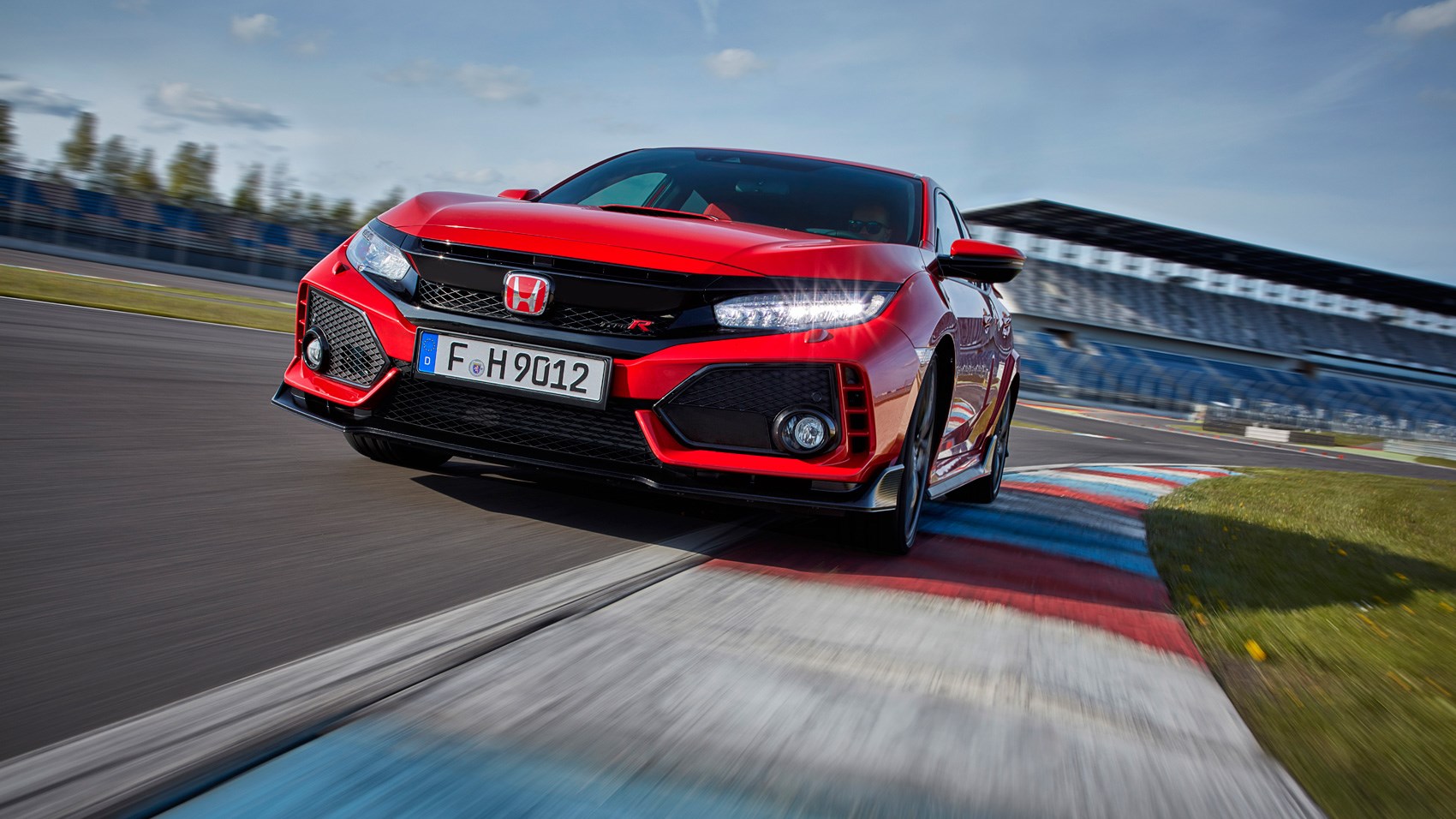
The mechanical limited-slip differential goes about its business brilliantly, its effect noticeable without dominating proceedings, and the steering geometry somehow manages to avoid much in the way of torque-steer despite the extreme power being put through the front wheels.
In the previous Type R there were two driving modes, with an effect on the adaptive dampers, power steering and power delivery. This time there are three, with a new Comfort mode for urban work (lighter steering, softer suspension – it works well) and a middle Sport mode as the default setting. This is the one you’ll want to use most of the time – the steering is responsive without being overly heavy, and the suspension taut but tolerable, the traction control intervention alert but subtle. It feels harder-edged than a Golf GTI, say, but more compliant than the old Type R – and the Ford Focus RS for that matter.
Then there’s ‘+R’ mode, for the firmest damping, heaviest steering and perkiest power delivery.
Yes, the old Type R had a +R mode too, and it made the suspension so firm you got double vision…
It’s less extreme this time – it’s very firm, yes, and still best left for a track or a particularly smooth bit of A-road, but doesn’t completely ruin the car’s composure as before. One thing it does do is make the steering particularly heavy – a setting which lead engineer Hideki Kakinuma says the team felt was the best match for the damping in +R. You can’t currently mix and match aspects of the drive modes – picking +R for engine and dampers, but Sport for steering, for example – but Honda may add this functionality later in the car’s life.
The steering itself isn’t particularly brimming with feel in any of the three driving modes, but it’s quick and direct. The variable-ratio rack does its job well enough, with response feeling linear and consistent.
Incidentally, the new Civic Type R’s turning circle is pretty good, too – not always the case with high-end hot hatches.
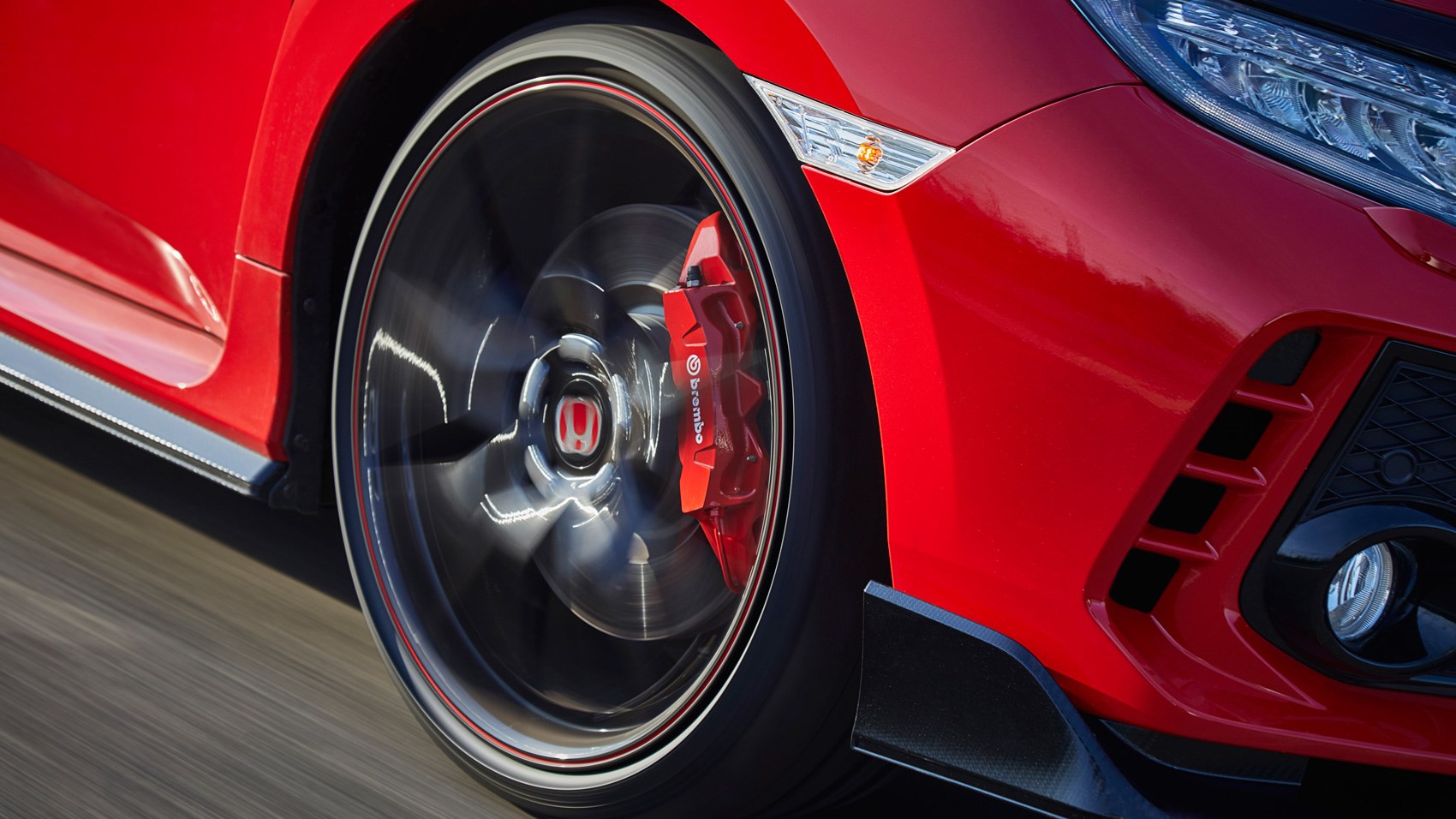
Just how fast is the FK8 Honda Civic Type R?
This is a pretty good case study of just how bonkers modern mainstream hot hatch performance is becoming. This is ostensibly a five-door family hatch, albeit a fairly spicy looking one, that gets from 0-62mph in 5.7sec and tops out at 169mph.
There’s no turning back in the hot hatch power wars; Honda says sales of C-segment cars with more than 300 metric horsepower have tripled between 2015 and 2016.
On paper the new Type R’s performance stats are fairly similar to its predecessor, but on the autobahn the new car feels absurdly fast. There’s some inevitable lag from the compact monoscroll turbo, but it’s well suppressed, and the engine still has an element of the revvy, slightly manic VTEC character. It’s very responsive, helped by a light flywheel and slender crankshaft, and even if there’s been ‘only’ a 10bhp power increase on paper, it feels like more on the road – accentuated by the shorter gear ratios. It sounds better than the old car, too, with a bassy tone from low revs and zingier one at the top end, a result of the new exhaust system.
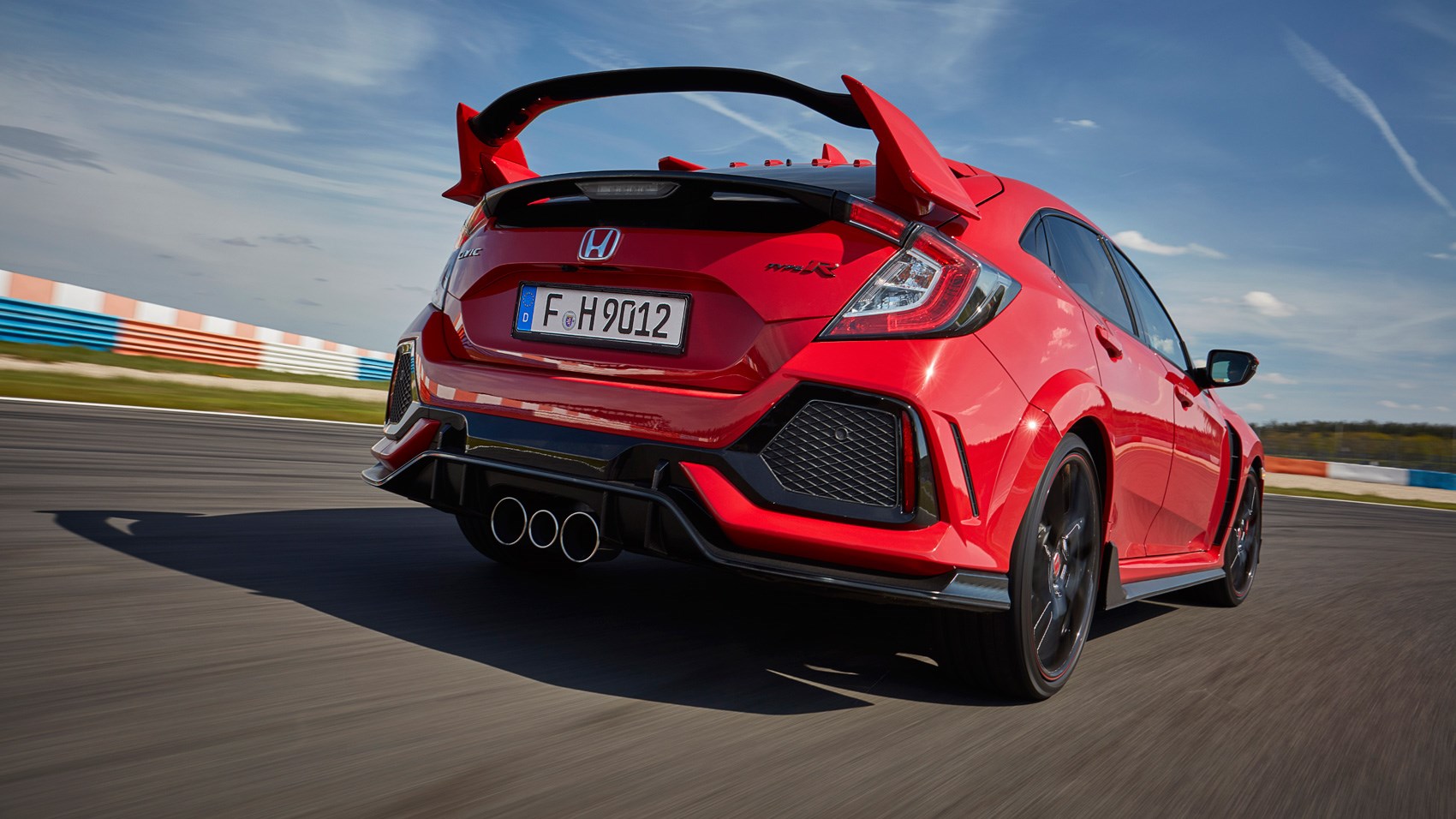
What on earth is that triple exhaust all about?
The two main tailpipes either side do the usual gas flow stuff, and so does the middle one at low to mid rpm. Above that, a negative pressure is created within the middle pipe, to prevent boomy engine noise getting into the cabin on the motorway. It works – at cruising speeds, this feels a refined, well-insulated car.
Is the new Civic Type R still built in the UK?
Yep, at Honda’s Swindon plant at the rate of 75 cars a day currently, a higher production rate than any previous Type R. That’s partly because it’s the first Type R Honda to be exported to the USA. The Swindon-constructed cars are also sold in Japan and continental Europe.
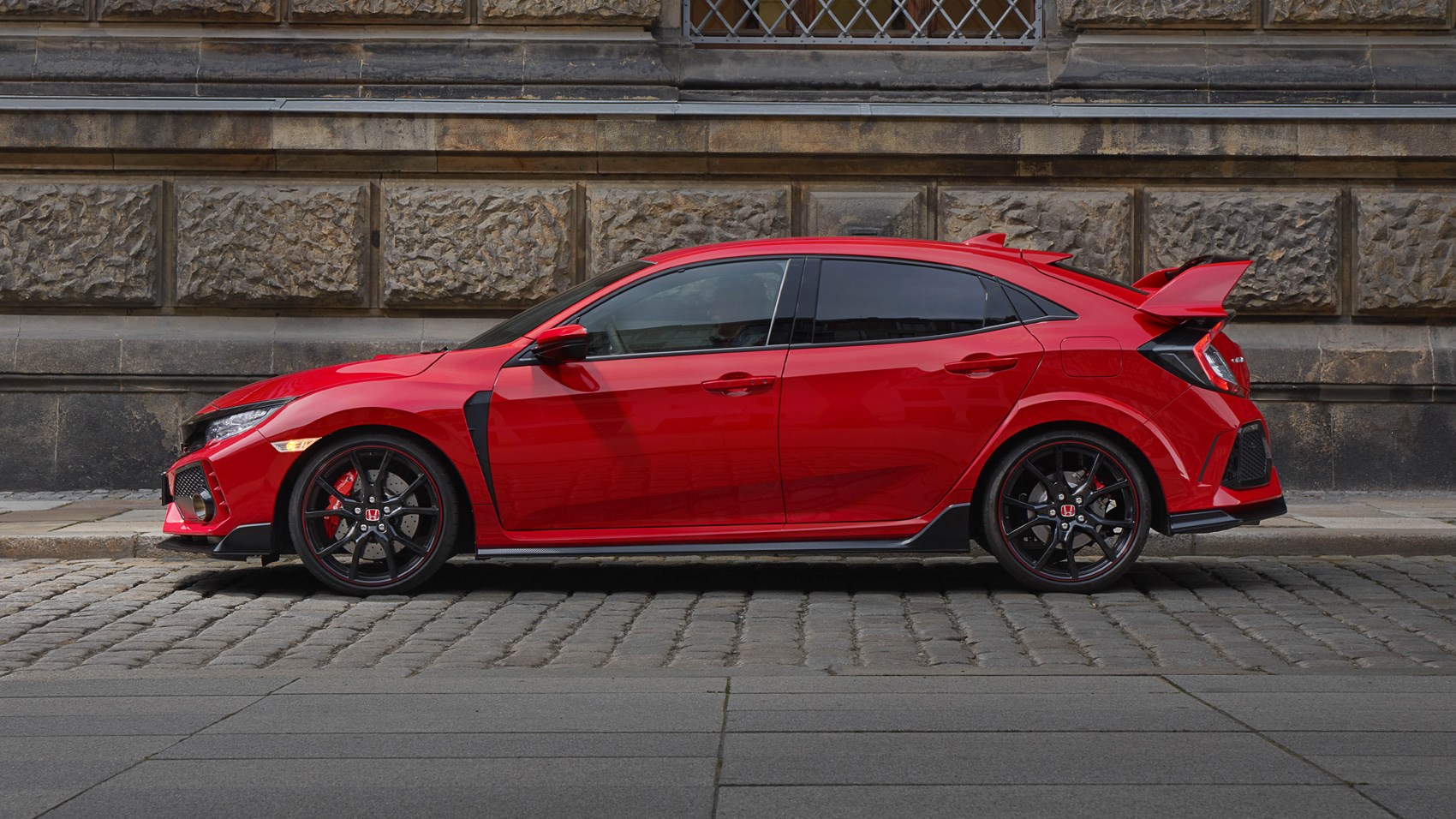
How much is the Honda Civic Type R FK8?
At launch, the basic Type R starts at £30,995, with the GT version an extra £2000 – the GT is expected to make up three quarters of sales.
Or PCP packages start at £299 a month on a three-year 5.9% contract.
What’s the difference between the Civic Type R GT and the regular Type R?
The GT’s longer kitlist includes:
- Sat-nav
- Wireless smartphone charging
- Blind spot monitoring
- Dual-zone climate control
- 11-speaker audio
- LED front foglights
You also get some extra colours (metallic blue, flat grey or ‘polished metal’ – not literally) in addition to the base car’s red, white or black.
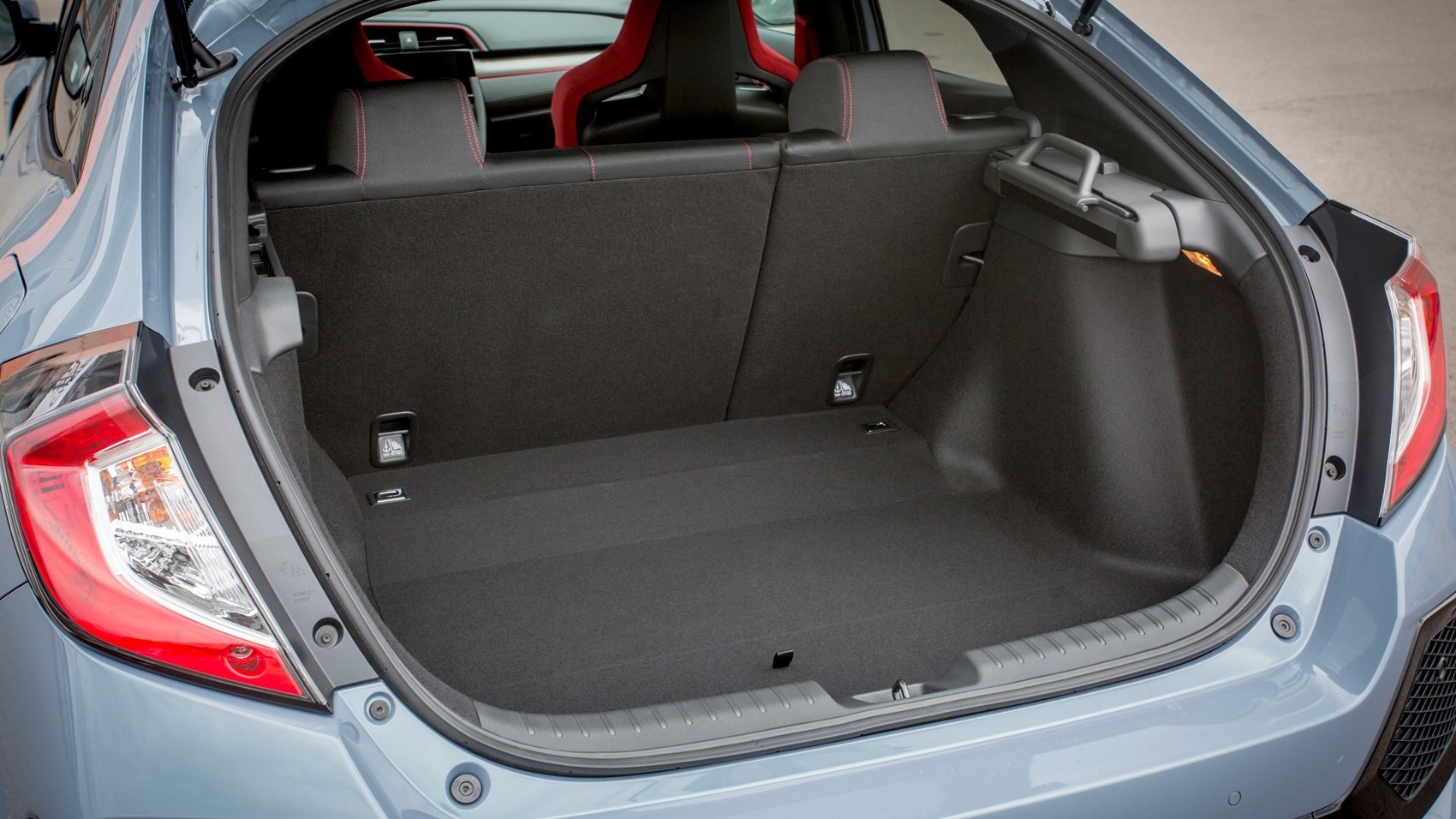
Do you still get a giant boot?
It’s still huge at 420 litres, although now with a slight ramp in the section of the floor closest to the rear seats to accommodate the central exhaust and rear suspension – not a deal-breaker, though. This is still a very roomy car.
One with a nicer interior than before, too, with less confusing ergonomics and brilliant new sports seats with comfortably squidgy yet supportive bolsters. If anything, they’re too supportive, the upper bolsters hugging my shoulders to the point of restricting their movement on track.
Verdict
Really, it’s a shame the new Honda Civic Type R has such OTT styling. This is a well-resolved, rounded modern hot hatch, even if it doesn’t necessarily look like it. As fast and agile as the Touring Car looks suggest, it’s also comfortable, practical and rewarding to drive at low speeds as well as high.
Most of the criticisms that could reasonably have been levelled at the previous Civic Type R have been addressed – the inflexible ride, boomy motorway noise, some of its more awkward ergonomics – and yet the new car is faster and better balanced, too.
The styling may narrow this car’s appeal but, based on these first few hours behind the wheel at least, it deserves a wide audience. If you’re a hot hatch fan, this is one of the very best of the current crop.
Check out our Honda reviews here